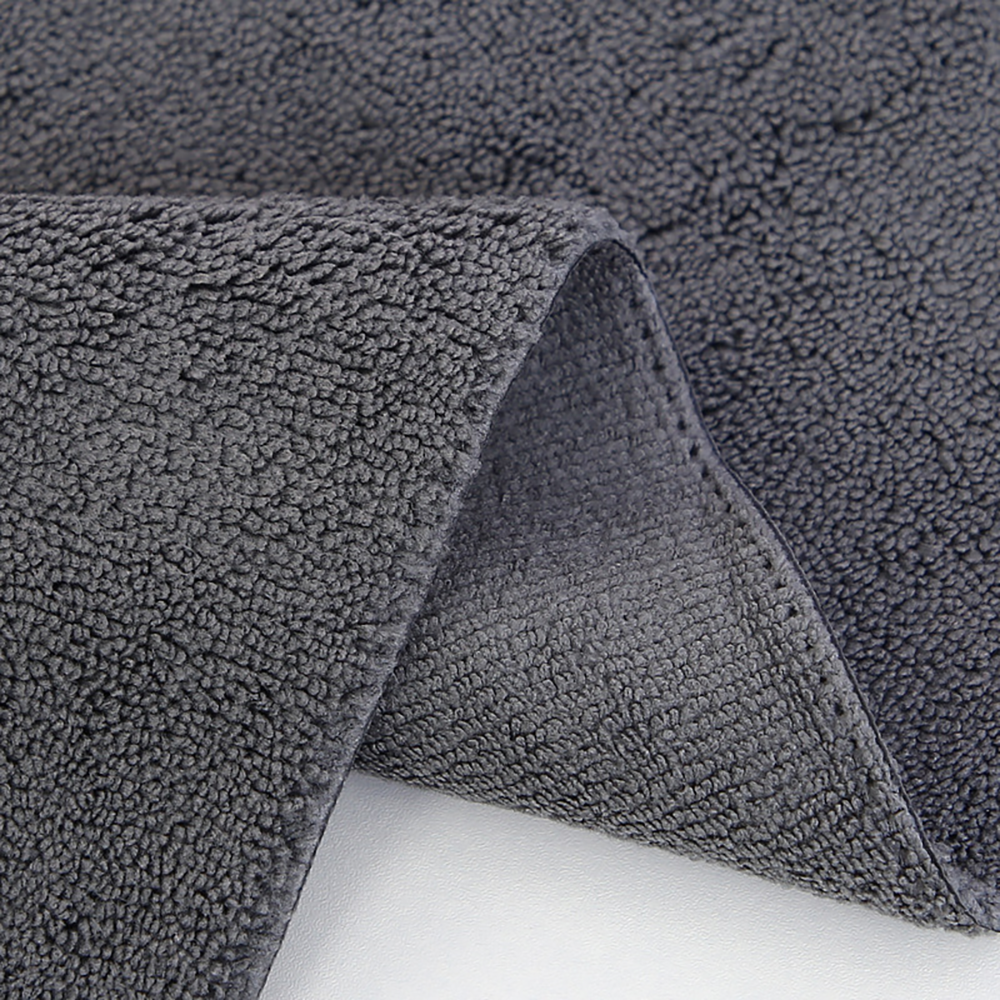Process characteristics of high-low pile car towels
The core technology of high-low pile car towels lies in their unique textile process. Through the carefully designed difference in the height of the terry loops, the functional characteristics of “one towel for multiple uses” are realized.
Principle of high-low pile structure: This towel adopts a special weaving technology to make the surface of the towel have both high and low pile structures. The high pile part (usually 5-8mm in height) is responsible for quickly absorbing a large amount of water, while the low pile part (about 2-3mm in height) is used for fine wiping and polishing. This design is inspired by the traditional high-low pile cut velvet bath towel process, but it has been innovatively applied in the field of car care.
Weaving process innovation: From the perspective of patented technology, the seven-weft high-low pile embossed towel fabric adopts a special warp winding method. The first warp is wound in the first, second and third wefts in the forward direction, passes through the third and fourth wefts, and is wound in the reverse direction on the fourth and fifth wefts to form terry structures of different heights4. This complex weaving method gives the product pattern a three-dimensional sense, a compact organizational structure, and different structures on the front and back sides.
Key to sizing process: In the production of high- and low-hair towels, sizing process is particularly critical. It is necessary to ensure that the high-hair part can stand up fully and avoid the short-hair part from being too hard. This is usually achieved by increasing the proportion of high-performance modified starch, while increasing the pressure of the sizing roller to ensure uniform sizing when the yarn is thicker. Properly increasing the moisture regain of the yarn can also help improve the flexibility of the terry.
Application of cut pile technology: Some high- and low-hair car towels will also use the cut pile process to cut the high-hair loop part so that the surface is covered with flat terry. This treatment can further enhance the hygroscopicity and softness of the towel. After cutting the terry, only the high-hair part is cut, while the short-hair part remains as it is, forming a functional partition.
Material selection and performance advantages
The material selection of high- and low-hair car towels directly affects their performance and life. Modern high-quality car towels mostly use special fiber materials to optimize the cleaning effect.
Dominant by microfibers: Most high-quality high- and low-pile car towels on the market are made of microfiber (ultrafine denier fiber), which is mainly a blend of polyester (polyester fiber) and nylon (polyamide fiber). This material has many advantages: the fiber diameter is extremely small (usually 0.1-0.3 dtex), the specific surface area is large, and it can capture and lock dust particles more effectively; it does not absorb water but the gap between fibers can store water, and it dries quickly and is not easy to breed bacteria; the fiber strength is high and it is not easy to shed and break.
Material performance comparison: Compared with traditional pure cotton towels, microfiber high- and low-pile car towels have obvious advantages. The hollow structure of pure cotton fiber is easy to retain water and dirt, and it will become hard and smelly after long-term use; while microfibers will hardly have these problems. Tests show that the water absorption of high-quality microfiber towels can reach 7 times their own weight, far exceeding ordinary cotton towels.
Special processing technology: High-end car towels will also use the process of dyeing first and then weaving to make the color more uniform and lasting, and avoid the squeeze damage to the terry loops caused by weaving first and then dyeing. Some products also undergo antibacterial treatment or add antistatic ingredients to further enhance the cleaning effect and user experience.
Weight and thickness: The weight of professional car towels is usually between 200-400gsm. Towels within this range have sufficient thickness and water absorption, but are not too bulky. Towels with moderate thickness are easier to wring out and are suitable for repeated use.
Functional characteristics and usage scenarios
High-low-hair car towels have multiple functions due to their special structure, which can meet the different needs of car care.
Dual functions of water absorption and polishing: The high-hair part is responsible for quickly absorbing large areas of water, such as water droplets after the car body is rinsed; the short-hair part is suitable for fine wiping and polishing of glass and paint to avoid leaving water marks or scratches. This design reduces the number of times the towel is changed during the care process and improves work efficiency.
Segmented usage scenarios: According to the different needs of car care, high-low-hair towels can have a variety of special types: body drying towels require larger sizes and higher water absorption; interior cleaning towels should be softer to avoid scratching the material; glass cleaning towels require a tighter weave to ensure no marks. Professional care kits usually include towels of various specifications.
Reduce the risk of scratches: High-quality high- and low-pile car towels have fine and soft fibers, which can greatly reduce the risk of leaving sun marks on the paint surface. In particular, towels that have been cut pile have more uniform surface pile, which is suitable for the care of high-end cars. When using, just wipe gently without pressing hard.
Durability and economy: Compared with ordinary towels, professional high- and low-pile car towels are significantly more durable. The high strength characteristics of microfibers enable them to withstand multiple machine washes without deformation or shedding.
Post time: Jul-01-2025


